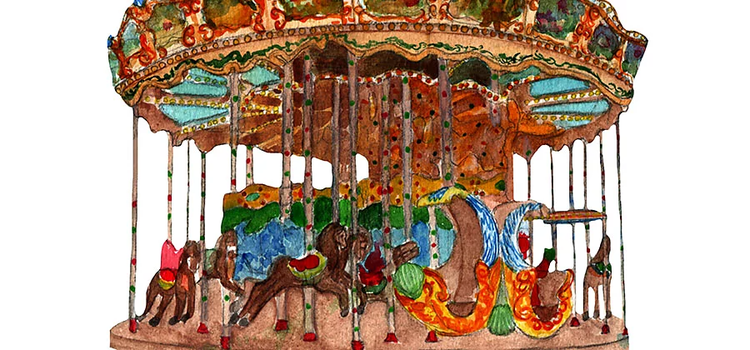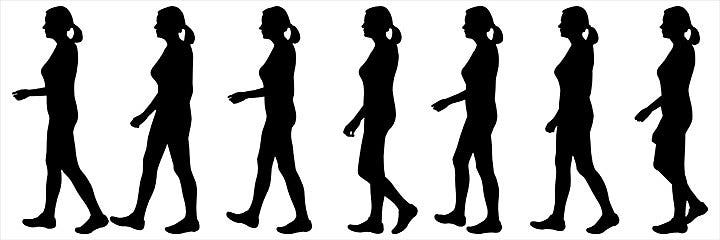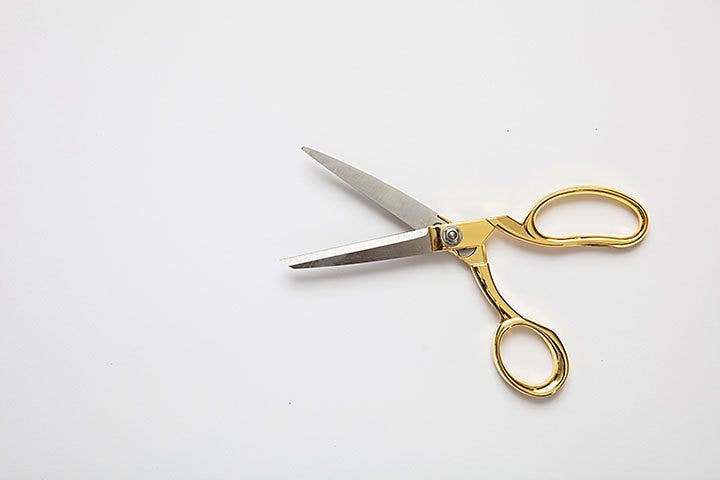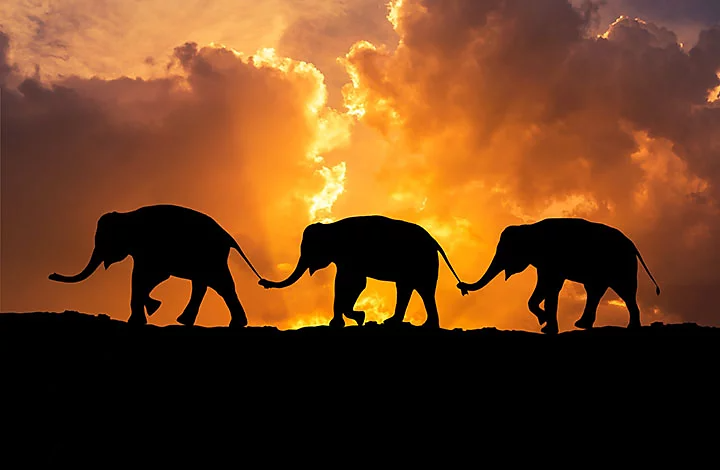Animation FEATURES
Zoetrope animation explained: definition, history and ideas.
Zoetrope animation is one of the most popular pre-film animation techniques. Originally developed in the 1830s, it became a popular Victorian toy. It is still used today - adapted and updated to make 3D versions by the likes of Pixar. Find out more about how this simple but effective technology works.

What is a zoetrope and how does it work?
A zoetrope is a cylinder with vertical slits down the sides. The inside of the cylinder displays a band with a set of sequenced images. When the cylinder spins, the user can see the pictures inside as they look through the slits, which prevent the images from blurring together. Combined with the rapid succession of images, the illusion of motion in a continuous loop is created.
History of zoetrope animation.
- In 1833, the phenakisticope was invented by Belgian physicist Joseph Plateau and Austrian inventor Simon Stampfer. This disc is considered the first widespread device used for animation. In a pamphlet that July, Stampfer noted the technique could be adapted to use cylinders and looped strips of paper.
- Taking note, William Horner, a British mathematician, created the first type of zoetrope in 1834. He named it the daedalum in a nod to the Greek myth of Daedalus. The viewing slits in Horner’s revolving drum were between the pictures, unlike later variations, which had them above.
- In 1867, William Lincoln patented the name zoetrope, which was a combination of Greek words zoe (life) and tropos (turning), to translate as ‘wheel of life’.
- Board game company Milton Bradley began selling the cylinders in the US, with London Stereoscopic and Photographic Company selling versions in the UK. They became a popular Victorian parlour toy. Children loved spinning their zoetropes and gazed in delight at the primitive animated images of moving horses and other animals.
- Soon after, a giant zoetrope, 50-feet in circumference and powered by a gas engine, was on display in the concert hall of Crystal Palace, London.
- Other animation devices, including flip books and the praxinoscope, followed. The basic principles of zoetropes and similar inventions eventually led to the creation of motion pictures in the late-1880s.
- Perhaps as a reaction to digital technology, zoetropes underwent a revival in the late-20 th century and were increasingly used and updated. Animator Eric Dyer invented his own version, removing the drum and using the fast shutter speed of a camera instead of slits. He made experimental films from 3D sculptures, called ‘cinetropes’.
- Building on the zoetrope revival, large and elaborate versions were made, as well as an ever-increasing number of 3D versions. Pixar Animation Studios created a 3D zoetrope featuring characters from Toy Story 2 (1999). The Toy Story Zoetrope has been shown in museums and galleries around the world.
- With its looped image sequences, GIF animation on the Internet could be considered the contemporary successor to zoetrope.

Examples of zoetrope animation.
- In 2012, animation studio Sehsucht, Berlin created a CGI 3D zoetrope carousel to represent the American Dream.
- In 2008, UK visual effects company Artem Limited built a 10-metre-wide, 10-metric ton zoetrope for Sony. The BRAVIA-drome featured 64 images of the Brazilian footballer Kaká and was named the largest zoetrope in the world by Guinness World Records.
- American horror film House on Haunted Hill (1999) featured a human-sized zoetrope chamber, dubbed ‘the Saturation Chamber’.
- Tokyo’s Ghibli Museum houses a 3D zoetrope featuring characters from the Japanese animation studio’s 1988 animated film My Neighbour Totoro.
- Inspired by Ghibli, Pixar’s Toy Story Zoetrope led to a further two 3D zoetropes. One is install at The Walt Disney Studios in Burbank, California, the other at Disneyland Paris.
- In 2012 the horror film The Woman in Black features a zoetrope spun by actor Daniel Radcliffe, which is peered through by the titular character.
- From 2007 to 2014, BBC Two used a zoetrope to create the effect of flying cars zooming around a futuristic cityscape for an ident, shown before TV programmes and on the BBC iPlayer.
- A haunted zoetrope toy features in the supernatural horror The Conjuring 2 (2016).
- Clothing company The Gap built a human-sized zoetrope to promote its ‘Meet Me in the Gap’ campaign. The giant multi-coloured wheel featured people dancing on the spot which, combined with the spinning cylinder and shot in 360 degrees, created an immersive experience of movement and colour.
- American performance art collective the Blue Man Group used a quick-spinning carousel to create a zoetrope effect at their shows in Las Vegas and Florida.
- UK supermarket Sainsbury’s celebrated its 150 th anniversary in 2019 with a giant zoetrope cake in a TV advert.
- New York advertising agency Johannes Leonardo created an advert for Volkswagen in 2021. The Wheel featured eight complex zoetropes that each told a part of the story of transport evolution. Each was made using various disciplines, including sculpture, hand drawing, cel animation, photography and 3D stop motion.
How to make a zoetrope.
You may not have access to the technology of studio giants like Ghibli and Pixar, but you can certainly make a vintage zoetrope at home.

What you’ll need.
- Zoetrope template. There are lots of templates online that you can use or feel inspired by. A popular example is to use images of galloping horses.
- A chopstick. Use one from a Chinese takeaway or you may want to order in bulk online - especially if you plan on making more than one.
- One compact disc. You may listen to music via streaming nowadays, leaving your CD collection untouched. Here’s something you can use them for.
- Two 1/8-inch x 1-inch zinc-plated fender washers. You can get these at most hardware shops or online.
- Scissors
- Tape
Making the zoetrope.
- Prepare the strip. Cut out the strips of your template. Fold both strips along the dashed lines. Next, cut out the marked rectangles on the template from both strips to create the viewing slits. With loops of tape, fold the sheets together.
- Put the strip together. With the pictures on the inside, tape the sheets together, creating a circle. Take care not to let any tape fold into the inside. Then, tape the outside of the circle to the edge of the CD. Try to keep the circle as round as possible and ensure there are no bulges.
- Zoetrope assembly. Place one washer tightly over the tapered end of the chopstick. Place the CD on the washer, ensuring the zoetrope strip is facing up. Next, place the second washer over the tapered end, to sandwich the CD between both washers. Take a small piece of tape and use it to hold the top washer to the chopstick. Make sure you don’t tape the washer to the CD.
- Use your zoetrope. Hold it at a slight angle. As you look through the slits you made, spin the CD. The pictures inside should be animated and appear to be moving. If they’re moving backwards, simply spin the CD in the opposite direction. It may take time to discover the right speed for spinning the CD to see the animation at its best.
Zoetrope ideas.
The best ideas for zoetropes revolve (literally) around the idea of simple movements. Here’s a few of the most popular to get you started:
- Animals. Galloping horses, walking elephants, flying birds, leaping lions, swimming fish.
- People. Dancers, weightlifters, jugglers, athletes, children, cartoon characters.
- Shapes. Shrinking and expanding stars, tumbling sticks, decreasing and increasing circles.

You could build a 3D zoetrope with models and static sculptures. With a spinning turntable, pipe cleaners, papier-mâché, a turntable and a strobe light, a 3D zoetrope is possible without 3D printing technology.
Zoetrope animation FAQs.
How many frames is a zoetrope?
The more frames per second, the greater the trick on the eye. The ideal frame rate is 24 frames per second and the minimum is 12 frames per second. A zoetrope spinning quickly at one rotation per second will need 12 frames to avoid flicker. However, such is the retro appeal of zoetropes, the flickering quality is often a large part of the charm.
Who invented zoetrope?
The origins of the zoetrope begin with Austrian inventor Simon Stampfer. He co-invented the phenakistiscope disc, regarded as the first widespread animation device, in 1833. Stampfer suggested the concept could be used with a cylinder. A year later, British mathematician William Horner came up with the daedalum. The definitive zoetrope was invented by American inventor William Lincoln in 1865 and patented two years later.
How fast should a zoetrope spin?
A typical zoetrope spins at less than 100 rpm. By comparison, a yo-yo reaches 5,000 rpm on an average throw. The comparative slowness of the zoetrope is another part of its quirky appeal to animators and viewers alike.